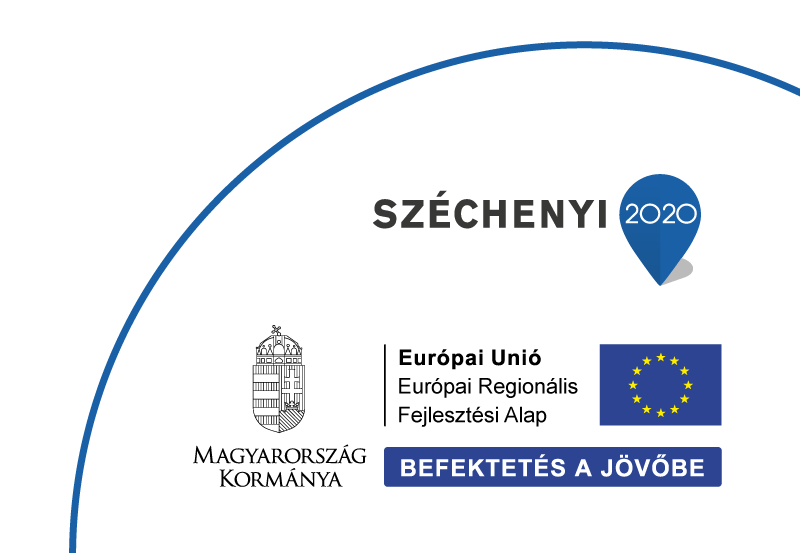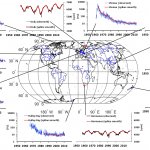 |
Tárgyfelelős | Dr. László Elemér |
| Szint | MSc | |
| Szak | BSc és MSc (Földtudomány) |
- Az izotópok alkalmazásának története a földtudományokban.
- Környezetei izotópok.
- Izotópanalitikai alapfogalmak, frakcionálódás.
- Az izotóparányok mérési módszerei.
- A stabilizotópok jellemzői.
- Az oxigén és a hidrogén izotópok földrajzi eloszlása.
- Az oxigén és a hidrogén izotópok szerepe a víz útjának nyomon követesében.
- Az oxigén és a hidrogén izotópok a felszíni és a felszínalatti vizekben.
- A radiogén izotópok és azok keletkezése.
- Az antropogén és természetes radiogén izotópok a légkörben.
- A radiogén izotópok forrásai.
- A természetes és antropogén trícium a légkörben és a vízburokban.
- Az izotópok felhasználása a múltbeli klímarekonstrukcióban.
Csatolt dokumentumok
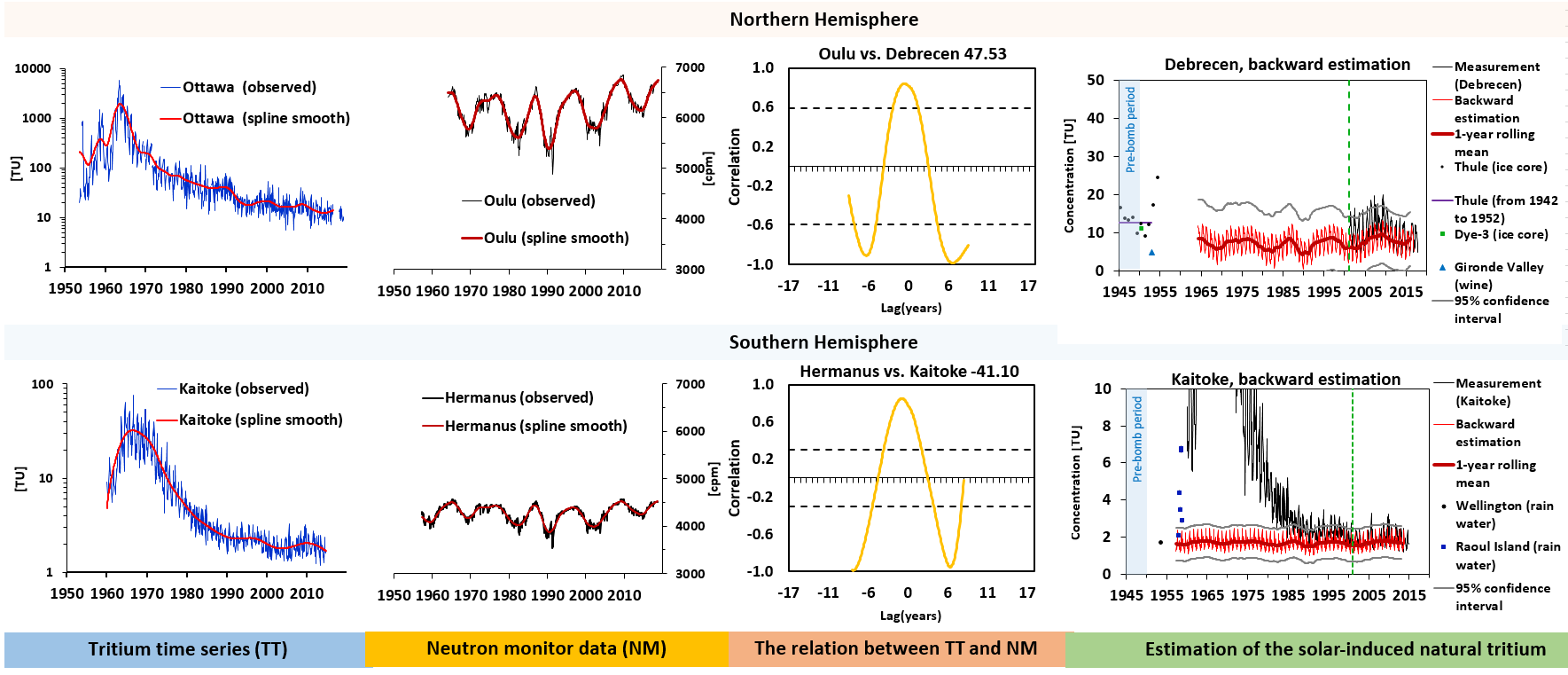 | ||
| Cím | Estimation of the solar-induced natural variability of the tritium concentration of precipitation in the Northern and Southern Hemisphere | |
| Publikálás éve | 2020 | |
| Szerző | László, E., Palcsu, L., Lellőssy Á. | |
| Kiadja | Atmospheric Environment | |
| Letöltés | Letöltés | |
Tritium has been long recognized as a useful tracer for the study of atmospheric transport, ocean circulation, and the global water cycle. In addition, the application of tritium measurements in various fields has grown signif- icantly in the last few decades. Since 1963, the atmospheric test-ban treaty, bomb tritium concentrations in precipitation have significantly declined. Therefore, in the last two decades, global tritium concentration of precipitation (including anthropogenic and natural sources) has almost reached a steady-state level. The aim of this study is to estimate the temporal variation of the natural tritium concentration of precipitation during the past decades. To do this, we use a backward predicting time-series model that exploits the correlation between precipitation tritium concentration and the secondary neutron flux in the atmosphere. The measured tritium time series of 21 Northern and two Southern Hemispheric stations are used, while neutron monitor (NM) data, which are widely compared to the production rate of cosmogenic isotopes in the atmosphere, is used as an external variable for the model. Backward predicting SARIMAX statistical models are fit on the period 2001–2018 and provide estimates of the natural precipitation tritium levels for the bomb peak period 1960–2000. Evaluation of backward estimations on the 1990–2000 test period yields RMSE measures between 0.5 and 4.6 TU for four of the 23 investigated stations, pointing out locations where the neutron flux is a good predictor of the precipitation tritium concentration. | ||
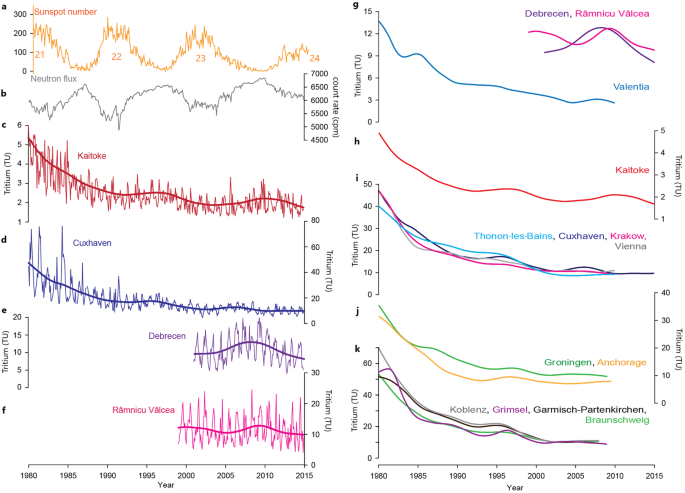 | ||
| Cím | Modulation of Cosmogenic Tritium in Meteoric Precipitation by the 11- year Cycle of Solar Magnetic Field Activity | |
| Publikálás éve | 2018 | |
| Kiadja | Scientific Reports | |
| Letöltés | Letöltés | |
The relationship between the atmospheric concentration of cosmogenic isotopes, the change of solar activity and hence secondary neutron flux has already been proven. The temporal atmospheric variation of the most studied cosmogenic isotopes shows a significant anti-correlation with solar cycles. However, since artificial tritium input to the atmosphere due to nuclear-weapon tests masked the expected variations of tritium production rate by three orders of magnitude, the natural variation of tritium in meteoric precipitation has not previously been detected. For the first time, we provide clear evidence of the positive correlation between the tritium concentration of meteoric precipitation and neutron flux modulated by solar magnetic activity. We found trends in tritium time series for numerous locations worldwide which are similar to the variation of secondary neutron flux and sun spot numbers. This variability appears to have similar periodicities to that of solar cycle. Frequency analysis, cross correlation analysis, continuous and cross wavelet analysis provide mathematical evidence that the correlation between solar cycle and meteoric tritium does exist. Our results demonstrate that the response of tritium variation in precipitation to the solar cycle can be used to help us understand its role in the water cycle. | ||
 | ||
| Cím | Tree ring radiocarbon | |
| Letöltés | Letöltés | |
Carbon-14 (half-life 5730 years) is produced by the reaction of secondary thermal neutrons derived from the primary cosmic-ray flux on nitrogen9. This 14C is incorporated into the terrestrial carbon cycle within 1–2 years as is most convincingly demonstrated through the14C signal of anthropogenic nuclear testing10. Miyake et al.2,3,4 were the first to study the annual signal of 14C in tree rings to reveal annual excursions, which were much larger than those observable in the decadally resolved international radiocarbon calibration curve (IntCal20). Specifically, they observed spikes in 14C activity at 774–775 CE and 993–994 CE2,4. The 774 CE event was first confirmed in a bristlecone pine record4, and indeed, this work encouraged many subsequent studies looking for both these events and searches for other events. Büntgen et al.5 summarizes 14C series of trees for 774–775 CE from 34 locations and another set of trees for 993–994 CE from 10 locations around the globe. Another rapid event at 660 BCE has been reproduced in different records and is therefore widely accepted. Separately, other rapid changes that may show more complex solar dynamo phenomena or combinations of solar and galactic events at 5480 BCE and 813 BCE have been observed. | ||
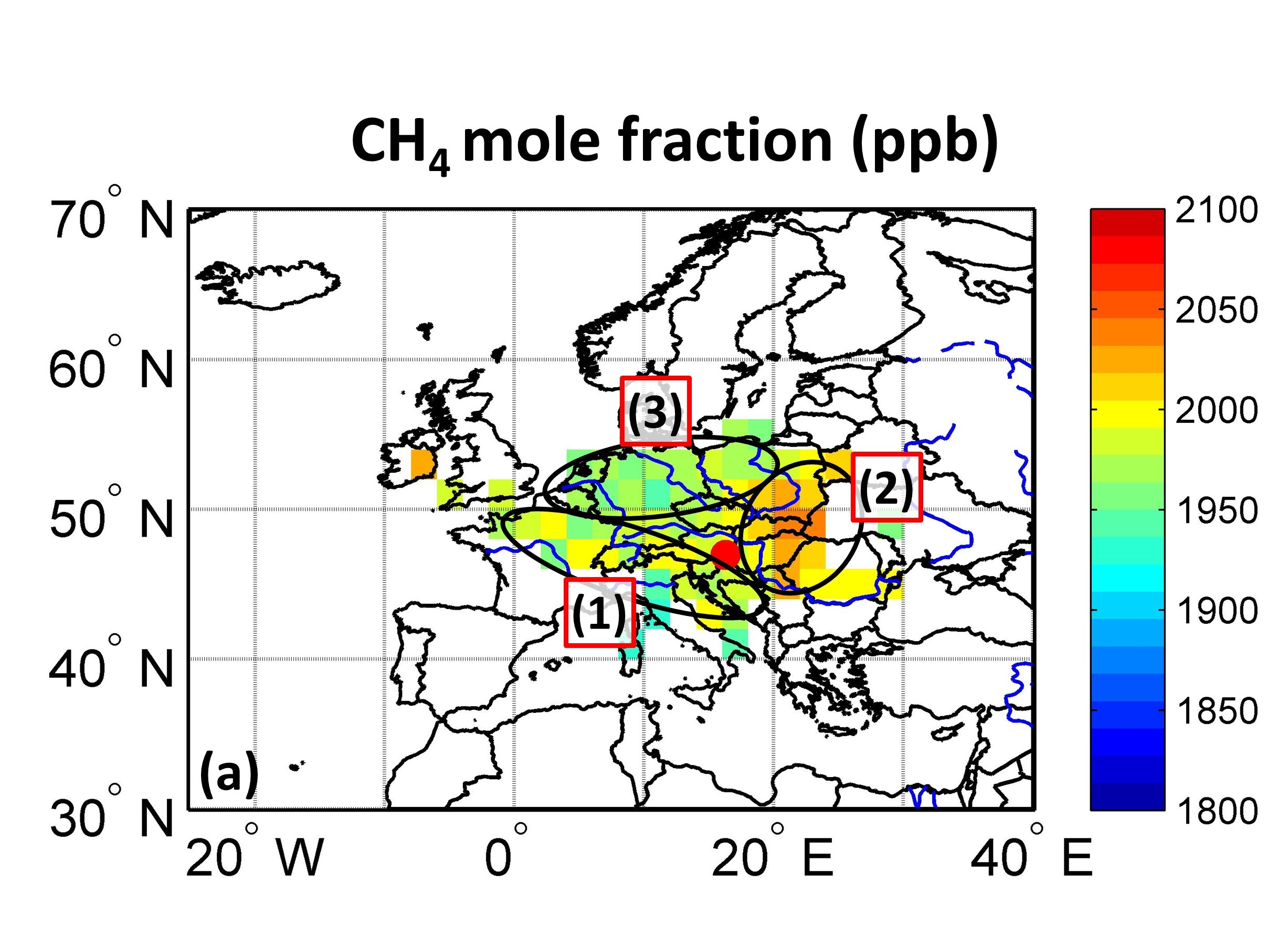 | ||
| Cím | Identification of Potential Methane Source Regions in Europe Using δ13CCH4 Measurements and Trajectory Modeling | |
| Szerző | László Elemér | |
| Letöltés | Letöltés | |
The methane emissions from the Hungarian Pannonian Basin are not well qualified, due to a lack of measurements of CH4 mole fraction and δ13CCH4 in the air. This study reports methane measurements in air samples from Hungary, placing them in the context of regional and global background data, to investigate the inputs to the methane burden in Central Europe. CH4 mole fraction and δ13CCH4 from the Hungarian tall tower station, Hegyhátsál, and additional data from Mace Head (Ireland) and Zeppelin (Svalbard) are used with back trajectory modeling to identify central European source areas and their seasonal variation between the summer vegetation and winter heating periods. Methane measurements in air masses sampled in the European interior, have significantly higher maxima and seasonal amplitudes than at the Mace Head and Zeppelin European background sites. The mean CH4 mole fraction value is about 80 ppb higher than the comparable marine background, and values above 2,000 ppb were frequently observed between February 2013 and December 2015. The mean δ13CCH4 value −47.5 ± 0.3‰ (2σ) was comparable to values at all three monitoring sites, but specific pollution events were detected at Hegyhátsál. Concentration weighted trajectory modeling, meteorological parameters, stable carbon isotopic composition (δ13CCH4), and Miller-Tans analysis show that the main factors influencing CH4 at the Hegyhátsál, apart from diurnal and seasonal changes in the planetary boundary layer, are emissions from residential heating and industrial CH4 emissions during the winter. | ||
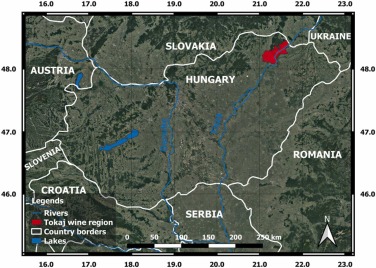 | ||
| Cím | Radiocarbon dating of microliter sized Hungarian Tokaj wine samples | |
| Publikálás éve | 2023 | |
| Szerző | Varga, T., Molnár, M., Molnár, A., Jull, A.J.T., Palcsu, L., László, E. | |
| Kiadja | Journal of Food Composition and Analysis | |
| Letöltés | Letöltés | |
Radiocarbon-based age determination of wine samples has a great tradition worldwide, but most of the applied techniques, such as liquid scintillation counting and gas proportional counting analyses, have had large sample size requirements. However, accelerator mass spectrometry (AMS) based radiocarbon dating methods require much lower amount of carbon. Up to now, only a few available studies applied the AMS method to the dating of wine. We tested a preparation and measurement protocol for wine radiocarbon dating, not only for the ethanol fraction but for the distillation residue and submilliliter level preparation method of the wine sample without separation was also applied, using capillaries of the twenty wine samples from the Hungarian Tokaj wine region. The reliability of our method was verified by a comparison of wine time series with the Northern Hemisphere Zone 1 atmospheric 14C data as a calibration curve. The measured 14C values of the two different fractions, the ethanol and distillation residue, and the milliliter-sized non-separated samples also were in good agreement with each other, which shows both fractions could be used for radiocarbon dating of wine samples. Small sample size (∼10 μL) wine radiocarbon dating does not destroy a significant part of a bottle of wine. | ||
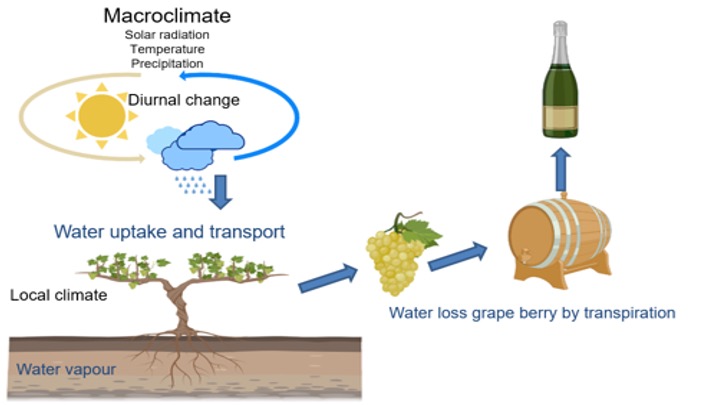 | ||
| Cím | Relationship between precipitation and wine tritium concentrations, Tokaj, Hungary | |
| Publikálás éve | 2022 | |
| Szerző | László, E., Zsigrai, GY, Novák, T., Palcsu, L. | |
| Kiadja | 6th International Congress on Water, Waste and Energy Management | |
| Letöltés | Letöltés | |
1. Introduction – The relationship between the elemental composition and quality of wine and geographical and climatic conditions is a well-known fact, which also significantly determines the international recognition of wines. The isotopic composition of Tokaj wines provides important information about changes in the environment and provides basic information for determining the authenticity of wines. Isotope analysis studies have previously shown that the isotopic composition of wines contains tritium from natural and artificial sources (tritium is a triple mass isotope of hydrogen with a half-life of 4500 ± 8 days). Much of the tritium of artificial origin was generated primarily by hydrogen bomb tests in the mid-20th century, while natural tritium is generated primarily by nitrogen in the upper atmosphere from cosmic radiation. The concentration of tritium in the current rainwater varies between 7 and 16 TU at medium latitude (TU: tritium unit, where 1 TU corresponds to 10-18 3H/1H, 0.119 Bq/kg for water), which is uptaken by grapevines through their root system. It may reflect the isotope composition of rainfall during the growing season. Therefore, bottled wine can retain long-term changes in the tritium concentration modulated by solar activity. 2. Experimental –Wine and precipitation samples have been analysed using the 3He ingrowth method. 3 The main principle of this method is based on the mass spectrometric measurement of the accumulation of 3He, because the daughter product of tritium is 3He. When analysing the samples, isotope dilution technique was applied, where an ultrapure 4He spike was added to the sample to eliminate systematic errors. This method is the most sensitive one that can be used to detect low-level tritium concentrations in environmental waters. The uncertainty of the 3He ingrowth method is about 0.1–0.4 TU in the range of 5- 20 TU. 3. Results and Discussion – The pattern induced by solar activity is well reflected in precipitation tritium concentrations, so the research sought to answer whether this natural variability can be detected in the isotope composition of wine samples as well. To explore this, we used a Tokaj wine stock covering a longer period (1999-2019). We have confirmed that the pattern observed in the precipitation is related to the tritium concentration values of the Tokaj wine samples, the correlation between them is significant (correlation coefficient: 0.66). In addition, we determined the isotopic composition (radiocarbon, strontium) characteristics of each vintage, which helps to determine the originality of valuable Tokaj wines specialties such as aszu. 4. Acknowledgment The research leading to this paper was supported by the János Bolyai Research Scholarship of the Hungarian Academy of Sciences, and also supported by the ÚNKP-21-5 New National Excellence Program of the Ministry for Innovation and Technology from the source of the National Research, Development and Innovation Fund. 5. References 1. Palcsu, L. et al. Modulation of Cosmogenic Tritium in Meteoric Precipitation by the 11-year Cycle of Solar Magnetic Field Activity. Sci. Rep. 8, 12813 (2018). 2. László, E., Palcsu, L. & Leelőssy, Á. Estimation of the solar-induced natural variability of the tritium concentration of precipitation in the Northern and Southern Hemisphere. Atmos. Environ. 233, 117605 (2020). 3. Palcsu, L., Major, Z., Köllő, Z. & Papp, L. Using an ultrapure 4He spike in tritium measurements of environmental water samples by the 3He-ingrowth method. Rapid Commun. Mass Spectrom. 24, 698–704 (2010).
| ||
 English
English
